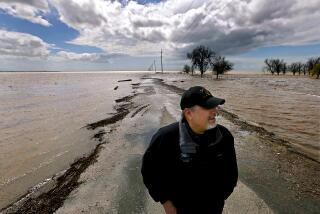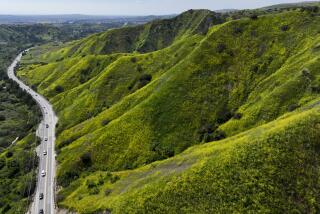Water Officials Issue Bleaker Drought Data
- Share via
SACRAMENTO — With the optimism spawned by March rains quelled by a dry April, state officials have produced a new, bleaker assessment of California’s water conditions that shows 1991 to be the driest of the five years of drought.
Forced by a “disappointing” April to revise their predictions downward, water officials said precipitation and runoff for the year are going to be less than they projected just a month ago.
“The drought continues,” Water Resources Director David Kennedy wrote glumly in a memorandum outlining the state’s water picture for the Water Resources Control Board and formally declaring 1991 as another critically dry year.
Instead of producing a continuation of the March rain “miracle,” officials said April gave them a double weather whammy--cold and dry days, which provided little additional precipitation and caused the Sierra snowpack to release less runoff than expected.
Rainfall, which in March was three times the normal amount for the month, dropped to only half of average for April, officials said. Although Southern California still recorded near normal rainfall for the year, state officials reported that precipitation in critical watersheds in Northern California remained well below average. Rainfall statewide for the water year beginning Oct. 1, 1990, stands at 74% of average.
“There is some improvement over last year in local conditions in some areas of the state, notably the southern Sierra and Central Coast regions, but overall, water conditions are poor and reservoir storage is much below normal,” Kennedy told the board.
But in an interview, Kennedy said the April disappointment will not prompt him to make “any significant change” either in the allocation of state water supplies to urban areas or in the amount of water he plans to have stored in state reservoirs by the end of the year.
He said supplies obtained through a state water bank have given him some cushion and he may still consider making a modest increase in deliveries from the State Water Project to urban users. That determination will be made in several weeks after additional runoff measurements have been taken, he said.
So far, the state has reduced its normal deliveries of water to municipal and industrial users, including the Metropolitan Water District of Southern California, by 80%. Agriculture deliveries have been eliminated and are not expected to be resumed this year.
With those reductions, Kennedy said he intends to be able to comply with Gov. Pete Wilson’s request that there be more water in storage at the end of the 1991 water year than at the close of the 1990 year.
Kennedy’s department has been criticized for allowing reservoirs to be drawn down substantially during the first four years of the drought. The department has defended that decision by saying that historical data showed California was not likely to experience a drought as long and as severe as the current one.
In the new assessment of water conditions delivered to the control board this week, projections were especially pessimistic for the Sacramento River Basin, a major Southern California water source, where total runoff for the year is expected to be 8.7 million acre-feet instead of the 9.1 million acre-feet forecast last month. The difference of 400,000 acre-feet is, according to Metropolitan Water District calculations, about enough to provide 2.2 million Southern Californians with water for a year. An acre-foot is about 326,000 gallons.
At 8.7 million acre-feet, the new runoff figure would make 1991 the eighth driest year on record--eclipsed only by 1977, 1924, 1931, 1976, 1939, 1929 and 1934, in order of dryness.
Because the Sacramento River Basin feeds both state and federal water projects, conditions in the basin are critical to water supplies for much of the state. Officials use basin runoff measurements to determine if a water year is to be classified as critical, dry, below normal, above normal or wet.
Summing up the latest assessment of water conditions, the Department of Water Resources reported: “In sharp contrast to March, April was far below normal in precipitation, causing seasonal figures to revert to their pre-March downward trend. April’s dry weather emphasized that California is still in a prolonged drought.”
Doug Priest, manager of the department’s drought center, said the unseasonably cold weather in April and early May in Northern California prompted revisions in the forecast for snowmelt runoff from the Sierra. He said cold nights coupled with warm days meant more of the snowpack than normal would be lost to evaporation. He also said the cold kept the snow on the mountains longer, giving it extra time to soak into the ground.
“The best of all worlds is to get a big snowmelt and then in the late spring have the weather turn real hot so it will melt rapidly,” he said. “This year, it’s been cold and it’s still cold.”
More to Read
Sign up for Essential California
The most important California stories and recommendations in your inbox every morning.
You may occasionally receive promotional content from the Los Angeles Times.










